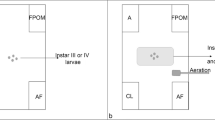Abstract
The caddisfly Sericostoma vittatum Rambur (Trichoptera: Sericostomatidae) is an endemic species of the Iberian Peninsula. Under laboratory conditions, larvae of S. vittatum had a higher activity and metabolism during the night. Besides consuming particulate allochthonous organic matter, young stages are also able to feed and grow on faecal pellets from adults. Daily growth rates varied from 0.02 mg (0.8–3.7 mg size class animals) to 0.31 mg dry mass (10.6–22.8 mg size class animals). Due to the high densities of this species (annual mean of 25 individuals m−2; maximum of 96 individuals m−2) and high consumption rates (0.47 mg leaf dry mass mg animal−1 d−1for small larvae), this species has a potential key role on the fragmentation of allochthonous organic matter of streams in central Portugal.
Similar content being viewed by others
References
Abelho, M. & M. A. S. Graça, 1998. Litter in a first-order stream of a temperate deciduous forest (Margaraça Forest, central Portugal). Hydrobiologia 386: 147–152.
Anderson, N. H. & A. S. Cargill, 1987. Nutritional ecology of aquatic detritivorous insects. In: Slansky Jr., F. & J. G. Rodriguez (eds), Nutritional Ecology of Mites, Spiders and Related Invertebrates. John Wiley & Sons, New York: 903–925.
Arsuffi, T. L. & K. Suberkropp, 1986. Growth of two stream caddisflies (Trichoptera). J. N. am. Benthol.Soc. 5: 297–305.
Barlöcher, F., 1991. Fungal colonization of fresh and dried leaves in the River Teign (Devon, England). Nova Hedwigia 52: 349–357.
Canhoto, C., 1994. A decomposição e utilização das folhas de Eucalyptus globulus como fonte alimentar por detritívoros aquáticos. Master Thesis. Universidade de Coimbra, Coimbra, 94 pp.
Cummins, K. W., 1974. Structure and function of stream ecosystems. Bioscience 24: 631–641.
Elliot, J. M., 1969. Life history and biology of Sericostoma personatum Spence (Trichoptera). Oikos 20: 110–118.
Feio. M. J. & M. A. S. Graça, 1997. Sericostoma vittatum: um detritívoro comum em rios do centro de Portugal. 2° Encontro Nacional de Ecologia. Coimbra. 17–19 de Dezembro.
Friberg, N. & D. Jacobsen, 1994. Feeding plasticity of two detritivores-hredders. Freshwat. Biol. 32: 133–142.
Gessner, M. O. & M. Dobson, 1993. Colonisation of fresh and dried leaf litter by lotic macroinvertebrates. Arch. Hydrobiol. 127: 141–149.
Gessner, M. O., E. Chauvet & M. Dobson, 1999. A perspective on leaf litter breakdown in streams. Oikos 85: 377–384.
Graça, M. A. S., 1990. Observations on feeding biology of two stream-dwelling detritivores: Gammarus pulex (L.) and Asellus aquaticus (L.). PhD Thesis, University of Sheffield, U.K.: 221 pp.
Graça, M. A. S., in press. The role of invertebrates on leaf litter decomposition in streams. International Review of Hydrobiology.
Graça, M. A. S., L.Maltby & P. Calow, 1993. Importance of fungi in the diet of Gammarus pulex and Asellus aquaticus II. Effects on growth, reproduction and physiology. Oecologia 96: 304–309.
Grafius, E. & N. H. Anderson, 1979. Population dynamics, bioenergetics and role of Lepidostoma quercina Ross (Trichoptera: Lepidostomatidae) in an Oregon woodland stream. Ecology 60: 433–431.
Illies, J., 1978. Limnofauna Europaea. Gustav Fischer. Stuttgart: 532 pp.
Iversen, T. M., 1979. Laboratory energetics of larvae of Sericostoma personatum (Trichoptera). Holarct. Ecol. 2: 1–5.
Paiva, J. A. R., 1981. Mata da Margaraça e a sua conversão em Reserva. Ann. Soc. Brot. 47: 49–66.
Prus, T., 1971. Studies on ecological energetics of Asellus aquaticus L. (Crustacea, Isopoda). Freshwat. Biol. 1: 287–305.
Rossi, L. & G. Vitaglio-Tadini, 1978. Role of adult faeces in the nutrition of larvae of Asellus aquaticus (Isopoda). Oikos 30: 109–113.
Subberkropp, K., 1992. Interactions with invertebrates. In Bärlocher, F. (ed.), The Ecology of Aquatic Hyphomycetes. Ecological Studies 94. Springer Verlag, Berlin: 118–134.
Triska, F. J., J. R. Sedell & S. V. Gregory, 1982. Coniferous forest streams. In Edmonds, R. L. (eds), Analysis of Coniferous Forest Ecossystem in Western United States. Hutchinson Ross, Stroudsburg, P.A: 292–332.
Wagner, R., 1990. A laboratory study on the cycle of Sericostoma personatum (Kirby & Spence) and light dark-dependent. Hydrobiologia 208: 201–212.
Webster, J. & E. F. Benfield, 1986. Vascular plant breakdown in freshwater ecossystems. Ann. Rev. Ecol. Syst.. 17: 567–594.
Author information
Authors and Affiliations
Rights and permissions
About this article
Cite this article
Feio, M.J., Graça, M.A.S. Food consumption by the larvae of Sericostoma vittatum (Trichoptera), an endemic species from the Iberian Peninsula. Hydrobiologia 439, 7–11 (2000). https://doi.org/10.1023/A:1004189316952
Issue Date:
DOI: https://doi.org/10.1023/A:1004189316952



